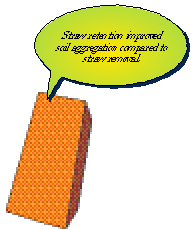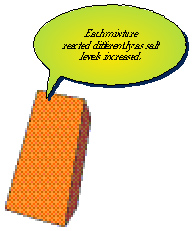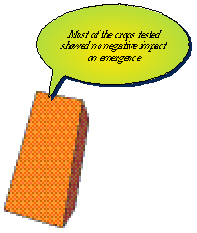
Features
Agronomy
Fertility and Nutrients
RESEARCH REVIEW: February 2008
Classical biological control of root maggot on canola, Optimizing the use of crop residues for soil quality and productivity, and on-farm and off-farm uses in the Gray soil zone, Strategies for improving the efficiency and crop safety of starter fertilizer
January 24, 2008 By Top Crop Manager
 Classical biological control of root maggot on canola
Classical biological control of root maggot on canola
In Canadian canola field, the principal parasitoids of root maggots are Trybliographa rapae, Aleochara bilineata
and Aleochara verna. In Europe, the principal parasitoids of root maggots in canola are Trybliographa rapae, Aleochara bilineata and Aleochara bipustulata. Comparison of the parasitoids in Europe and Canada suggest that Aleochara bipustulata could be a candidate for introduction to Canada for classical biological control.
In laboratory studies it was determined that the time of spring emergence of cabbage root maggots in Prairie Canadian canola is delayed relative to that observed
in previously studied populations of the same insect.
This indicates the need for selecting parasitoids for introduction from populations that can accommodate this
late emergence.
The researchers concluded that Aleochara bipustulata
should receive intensive study as it is a promising candidate for introduction for biological control of cabbage root maggots in canola in the prairie provinces of Canada.
Dr. N.J. Holliday, University of Manitoba with funding from the Manitoba Agri-Food Research and Development Initiative.
 Optimizing the use of crop residues for soil quality and productivity, and on-farm and off-farm uses in the Gray soil zone
Optimizing the use of crop residues for soil quality and productivity, and on-farm and off-farm uses in the Gray soil zone
An eight year (1998 to 2005) field experiment was conducted at Star City, Saskatchewan on a Gray Luvisol soil using a four year crop rotation. The effects of tillage and crop residue management on yield, N uptake and C removed in seed, straw, chaff or root were higher under no-tillage (NT) than conventional tillage (CT) in years with limited moisture, and also higher with straw retention than straw removal in many cases. Light fraction of organic matter, C, and N were higher with straw retention than straw removal and also higher under NT than CT.
Soil nitrate-N tended to increase with N rate. Straw retention improved soil aggregation compared to straw removal. Amount of N lost as N2O was higher from N fertilized than from zero N plots and was higher in CT than NT. In conclusion, retaining crop residues along with no tillage improved some soil properties, and may be better for the sustainability of high crop production and the environment.
Drs. Malhi and Lemke, Agriculture and Agri-Food Canada with funding port provided by the Agriculture Development Fund of the Saskatchewan Department of Agriculture and Food.
 Forage establishment on salinity affected land
Forage establishment on salinity affected land
Soils affected by high levels of salinity are non-productive as well as environmentally and aesthetically hazardous. These areas are expanding, which is cause for concern to producers and land managers. The purpose of the study was to demonstrate and evaluate how four different forage mixtures establish and develop on moderate to severe salinity affected land.
The trial was set up in five miles northwest of Swift Current. The plots were seeded down a gradient ranging from virtually non-saline to severely saline. All mixtures established well under conditions of low salt concentrations. Each mixture reacted differently as salt levels increased. As a result of initial observations, the following mixtures were rated from most tolerant to least tolerant:
• Garrison creeping foxtail, Courtney tall fescue, Altai wild rye grass, alfalfa.
• Smooth brome grass, Slender wheat grass, Russian wild rye grass, alfalfa.
• Crested wheat grass, Russian wild rye grass, Tall wheat grass, alfalfa.
• Dahurian wild rye grass, Intermediate wheat grass, Meadow brome grass, alfalfa. Wheatland Conservation Area Incorporated, Swift Current, Saskatchewan with funding from Agri-Arm.
 Strategies for improving the efficiency and crop safety of starter fertilizer
Strategies for improving the efficiency and crop safety of starter fertilizer
A series of experiments on the effects of form and rate
of seedrow placed phosphorus (P) and potassium (K) fertilizer were carried out under controlled environmental conditions using flats of a P-deficient Brown Chernozemic soil. The experiments were conducted in the laboratory and growth chamber using rates of seed placed P fertilizer up to 100kg/ha P2O5 without and with K fertilizer added at 20kg/ha K2O.
Two forms of mono-ammonium phosphate fertilizer were compared:
1. conventional MAP and
2. controlled release phosphorus (CRP) fertilizer (Agrium) made with a polymer coating to slow the release of phosphate to soil solution.
Eleven crops were utilized in the study: wheat, canola, pea, flax, oats, mustard, canary seed, chickpea, pinto bean, alfalfa and brome.
Most of the crops tested showed no negative impact on emergence with seed placed conventional P fertilizer, with or without 20kg/ha K2O potash addition, at rates up to ~20 to 30kg/ha P2O5. Pea flax and mustard tended to be most sensitive to high rates of seed placed MAP while wheat and oats were least sensitive.
The controlled release phosphorus fertilizer (CRP) product greatly increased the tolerance of crops to high rates of seed placed P, with rates of 80kg/ha P2O5 placed in the seedrow producing no significant injury for most crops. This effect is attributed to the coating reducing the harmful salt effect that occurs when high rates of fertilizer are placed in the seedrow in close proximity to the seed.
Generally, a rate of 30kg/ha P2O5 was sufficient to produce maximum early season biomass yield and P uptake for both conventional MAP and CRP fertilizers. Large differences in early P availability were not evident between the conventional P and controlled released P fertilizer products.
Saskatchewan Agriculture Development Fund. n